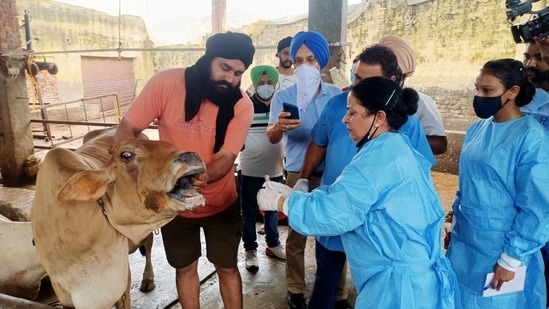Indian veterinarians are facing a dire crisis. Help them, now
In the past few years, on the heels of the worst public health crisis, veterinarians contend with the same struggles that have plagued them for decades — institutional travails, inadequate equipment and a myriad of other challenges
When the pandemic hit India, trained veterinarians stepped in to serve an unusual kind of patient: People. In many parts of the country, vets led thermal screening, performed Covid-19 tests, collected samples from people, and looked after India’s livestock and companion animals.

All this, while at personal risk of exposure. In 2021, at least 300 frontline vets tested positive for Covid-19. In Uttar Pradesh, at least 70 veterinary staff lost their lives to Covid-19 in the second wave, while hundreds of others were denied free treatment, early vaccination, and financial support for their families.
Vets received minimal attention during the pandemic. Without the reports from Uttar Pradesh, the contributions and sacrifices of vets would have been overlooked entirely.
It is one thing to celebrate the resilience of the veterinarian community on World Veterinary Day, but an entirely other to ask of ourselves: Do we know enough about our veterinarians?
The sparse data available tells us that about 3,000 veterinarians graduate from 54 veterinary colleges every year. It is, therefore, safe to say that there may be close to 100,000 registered veterinarians in India today. Meanwhile, conservative estimates point to a livestock population of 530 million.
The ratio of the number of patients and doctors is staggering.
Many pressing concerns like poor animal welfare practices and unscientific use of antibiotics stem from a lack of trained veterinarians and stewardship. In rural areas, para-veterinarians tend to fill this widening gap where possible. This group of animal health workers undergo some training, but do not have a university degree in veterinary care.
Consequently, paravets cannot deliver responsible decisions on animal health and welfare. This in turn increases our risk of other, less-understood zoonotic diseases. There are at least 816 other identified zoonotic diseases that threaten public health today. We are woefully unprepared for what lies ahead.
This is not a new insight. Back in 2011, a report from Centre for Agriculture and Bioscience International (CABI) stated that India, due to a growing livestock population, has a high risk of zoonotic disease outbreaks. This report also stated that the Government of India acknowledged the role of veterinarians in controlling these zoonotic diseases.
Yet, in 2022, on the heels of the worst public health crisis in the recent past, veterinarians contend with the same struggles that have plagued them for decades. From institutional travails to inadequate equipment and protective gear, veterinarians face a myriad of challenges away from the public eye.
Inadequate frontline support, insufficient awareness and education, and blithely ineffective administrative decisions are some of the major complaints reported by veterinarians.
A 2022 Parliamentary Standing Committee report found that the Department of Animal Husbandry and Dairying had no reported measures in place to resolve the existing shortage of veterinarians and para-veterinarians in the country. The Standing Committee also found that the Department of Animal Husbandry and Dairying was allotted funds to improve animal welfare and veterinary services. However, between 2016 and 2022, funds worth ₹139.84 crore were not utilised by the department.
For veterinarians out in the field, this means overwhelming pressure to educate farmers and animal caretakers, spread awareness on health and medicine, and maintain long-term animal and public health, without essential staff, vehicles, psychological support or medical equipment and facilities.
It is vital that the veterinary faculty, field veterinarian, and paraveterinary workforce is expanded, and quickly. Dr. Dinesh S Mohite, FIAPO’s Sr. Manager-Veterinarian, points out, “Unlike developed countries, we do not have a concept of a Veterinary Nurse who can be a great assistance to vets in reducing their burden.”
The roles and responsibilities of para-veterianians must also be clearly defined to ensure consistent and scientific decision-making in the field, he adds.
Instead of stepping back to assess the gargantuan veterinarian burden, we persist with unregulated animal farms, unauthorised slaughter and meat markets, shameful welfare and health for rural animals, and funds that never seem to materialise. And when a pandemic strikes the globe, vets are forced to take ownership of the zoonosis threat.
Is it hard to believe then that there is a dangerous mental health crisis sweeping through the veterinary community? Worse, we don't know how far gone the problem is in India. If reports from other, more developed countries are to guide us, veterinarians are more than twice as likely to die by suicide than the general population. Female vets are at an even greater risk of suicide.
According to Dr Mohite, many veterinary health professionals already suffer from zoonotic disease like tuberculosis, brucellosis, rabies, and so on. He adds that because of Covid-19, the threat of zoonotic diseases have been established, but what about veterinarians' mental health?
Veterinary institutions must systematise individual mental health and well-being. It is also vital that the Department of Animal Husbandry and Dairying diversify and expand the veterinary workforce and direct allocated funds toward veterinary resources and equipment.
If we don’t act now, the first to face the onslaught of future outbreaks will be India’s underequipped, underfunded, and underappreciated veterinarians.
Bharati Ramachandran is the CEO of the Federation of Indian Animal Protection Organisations (FIAPO), India’s apex animal rights body
The views expressed are personal
Continue reading with HT Premium Subscription




